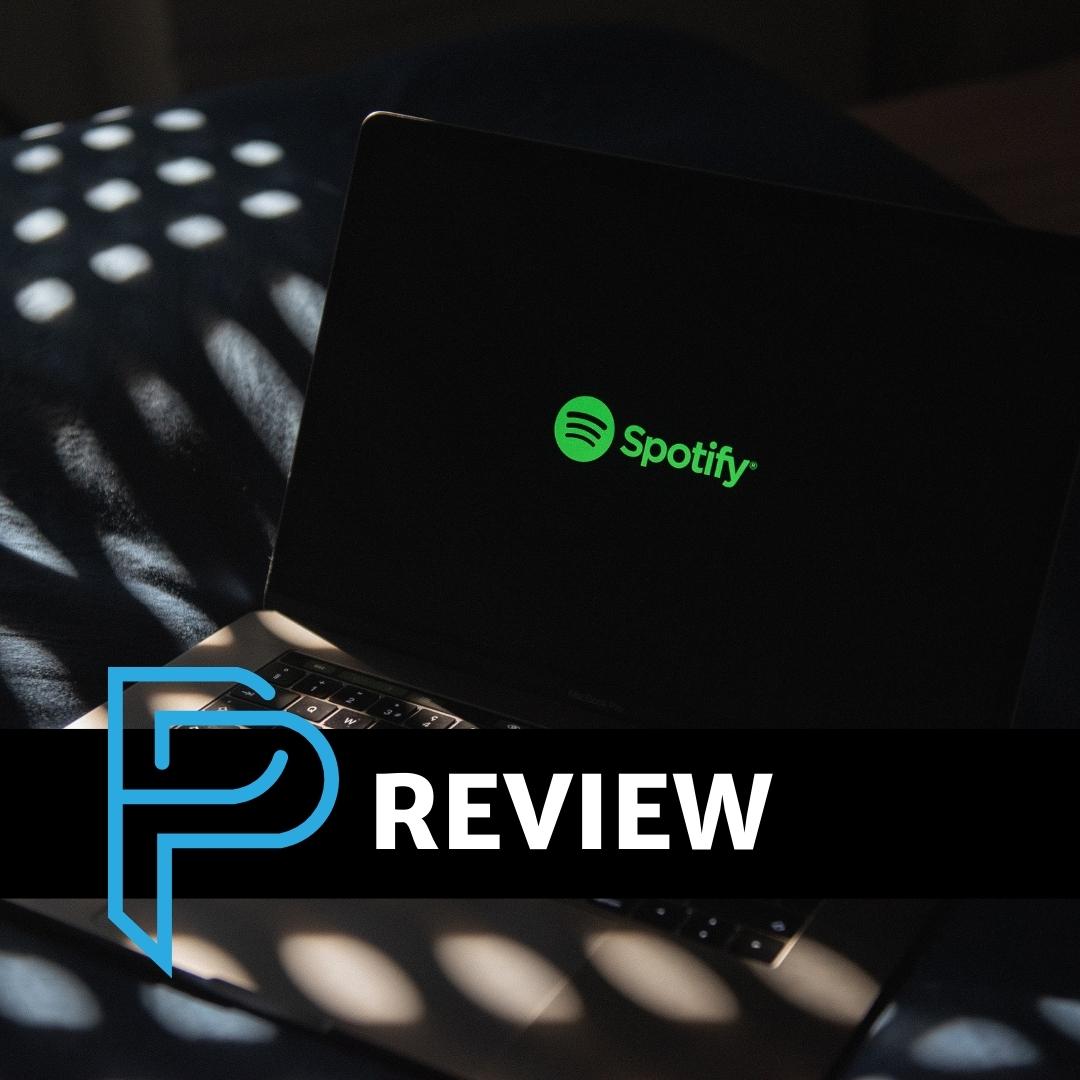If you’re reading this, chances are good that you’ve searched “Playlist-Promotion.com review” and you’re looking for a quick take on 1) whether or not the company is legit and 2) whether or not their Spotify promotion actually works.
Here’s my quick take: Yes, the company is legit, and yes, their Spotify promotion works.
You can click here to give them a try. Note that the link there is an affiliate link, so if you do click it and run a campaign with them, I’ll get a small commission that I’ll probably use to buy a new pack of cozy socks.
I’m offering the opinion above based on a trial of the company’s “100K Follower Reach” campaign. Over the course of a little more than a month, Playlist-Promotion.com was able to deliver close to 50,000 streams via inclusion on 23 playlists.
I checked the playlists using Spot On Track and tracked the streaming data they generated in our Spotify for Artists portal; based on that analysis, the numbers the campaign generated are real (meaning the streams represent actual, human listeners, not bots).
All told, it’s a pretty impressive return, which is why I have the company listed as one of my top Spotify promotion companies.
That said, I do have a caveat to the campaign, too – my primary note is that, while I’m impressed by the performance of the lists, I don’t necessarily love the fit of every playlist we were placed on.
All right, I’ll pause my “quick take” there before “quick” becomes a misnomer. If you’re interested in the details behind my campaign with Playlist-Promotion.com (and, let’s be real, if you’re planning to spend a few hundred bucks with them, you probably should be), keep reading for the complete breakdown.
The backstory on my campaign with Playlist-Promotion.com
Okay, first things first: I want to clarify that the campaign I ran with Playlist-Promotion.com was delivered for free, with the expectation that I’d write a review of my experience. As you’ll see below, I’m not allowing the fact that the campaign was free to bias my opinion of its results. I’ll dig into both the good and the bad in this write-up.
Also, I want to make it clear that I do this kind of stuff fairly often. As I’ve written before, ever since I’ve had a post rank for the search term “Spotify promotion”, I’ve had a steady stream of requests from companies asking if I’ll review their offerings. I usually say yes. At this point, I’ve tried over a dozen different services with wildly varying degrees of success.
It’s been interesting. Well, to put it more bluntly, it’s been straight-up weird – this is a strange field, for sure, and some of my experiences with playlisting companies have been kind of awful.
But enough about that. My point is to a) let you know that the campaign was a trial, and b) to not-so-humbly note that I have a lot of experience with this stuff, which I think gives me a pretty good idea of how to evaluate it.
Anyway, here’s the email that started things off for this campaign with Playlist-Promotion.com:

As you might glean from that, I’d tried these guys a couple of years ago and had decent results. Essentially, they wanted me to retry their service and see if things had improved.
I said yes, and after a bit of back and forth with their team and a couple of artists that I’ve worked with, we settled on promoting this song:
It’s a rock-pop track from California-based group, Mama Said (who, by the way, are awesome and are totally worth following if you like female-fronted rock music or have a pulse).
I’d run some promotion for the group over the previous year, but we’d been having a hard time driving streams for them on Spotify. Before the campaign, “Diamonds & Cigarettes” was literally sitting at less than 1,000 streams and had been notching between 0-22 streams each day.
To illustrate, here’s the Spotify for Artists stream count – note the near-zero streams line right up until the campaign started in September of 2022.
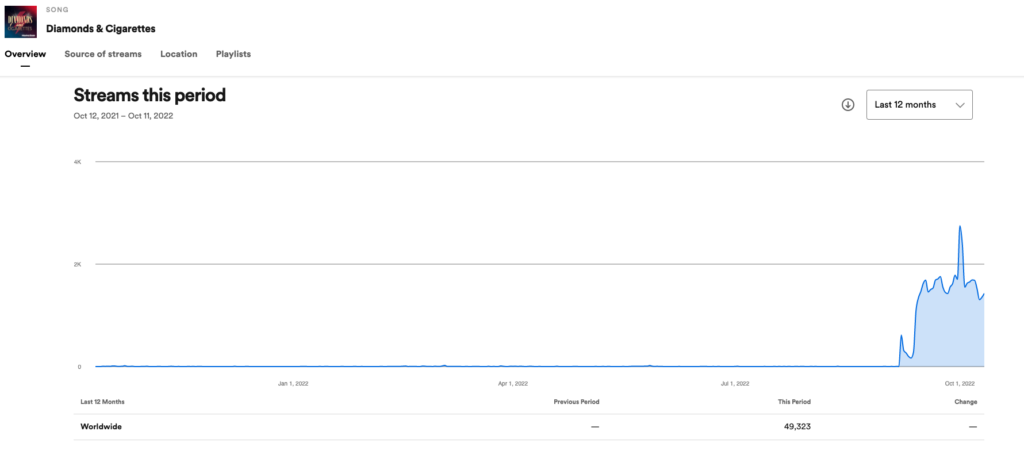
As you can tell, once we submitted the song, things took off pretty quickly.
How the campaign worked
Once we submitted the song, Playlist-Promotion.com’s team got in touch with me to set expectations. Here’s the email they sent:
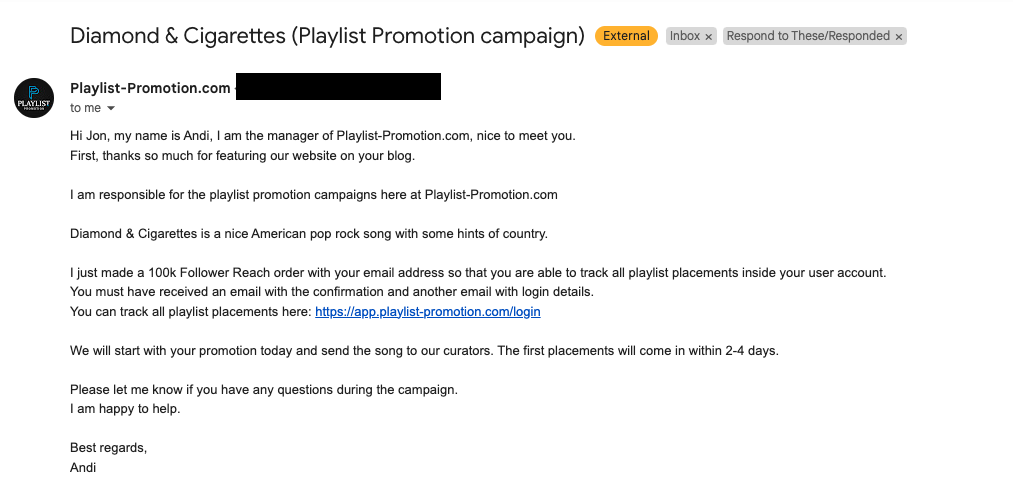
As Andi mentioned there, that was followed by an automated email that included the link to the campaign portal. I logged in to check it out, and it looked pretty legit:
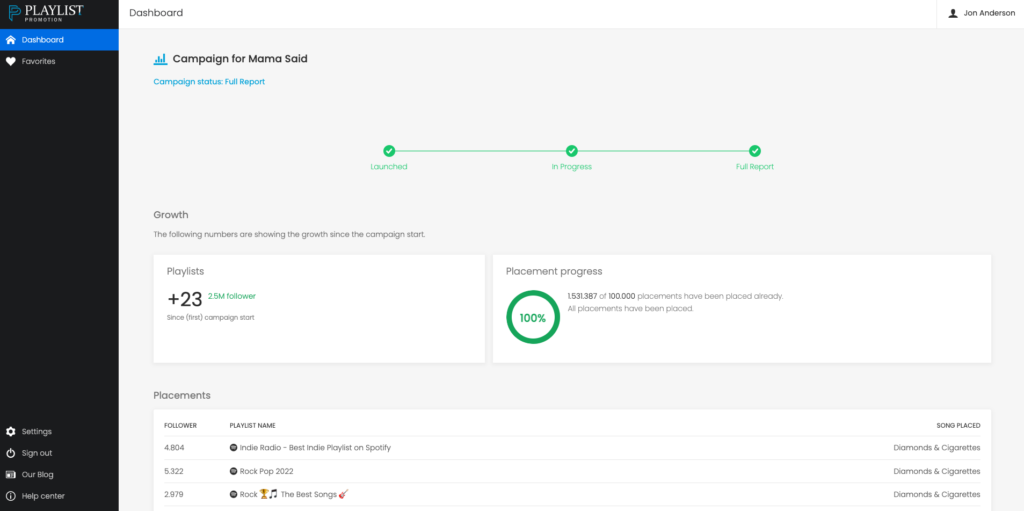
That’s what they call the “Full Report” on the campaign. Basically, it shows a list of all of the playlists we were featured on. If you click on a playlist, you get meta data about your placement, including a link to the playlist itself, how many followers the playlist has, and the position your song was added at.
Playlist Push was the first company I used that did this type of thing, but over the past couple of years, more and more of the good playlisting companies have been doing it. Honestly, Playlist-Promotion.com’s version is pretty slick.
Campaign timeline
In Andi’s email, he mentioned that they expected the first placements to arrive within 2-4 days. That turned out to be the case, and over the course of the month, more placements kept coming in. As you can see in the portal image, we ended up way overshooting our target of 100K total followers, finishing September with placements totaling over 1,500,000.
Yes, you read those zeroes right – it’s literally 15x the target, delivered in one month.
Andi kept me updated as the campaign went along, and I had access to the portal to track individual playlists, too. All in all, it was a well-communicated (and efficient) process.
The results of the campaign
Time to get into the good stuff. I’ve kind of given away the punchline in my opening couple of paragraphs, but I’ll repeat it just because it’s fun: Over the course of a bit more than a month, the campaign generated close to 50,000 streams.
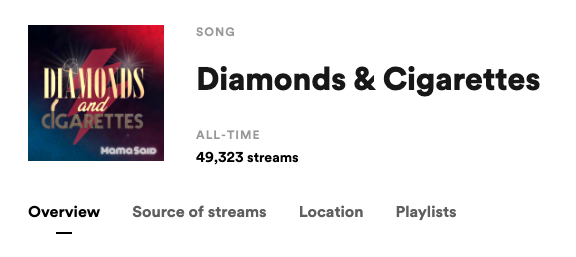
Now, if you’ve been looking into Spotify promotion, you know that the raw numbers are only the beginning. The deeper questions are:
- Are the streams from real listeners?
- Are the streams from engaged listeners?
Let’s unpack the answers in more detail.
First up…
Yes, the streams are from real listeners.
I think it’d be a waste of space to show you all 23 playlists we were placed on, but here are a few of the biggest ones:
If you plug these guys into Spot on Track (or a free tool like isitagoodplaylist.com), here’s what you’ll see:
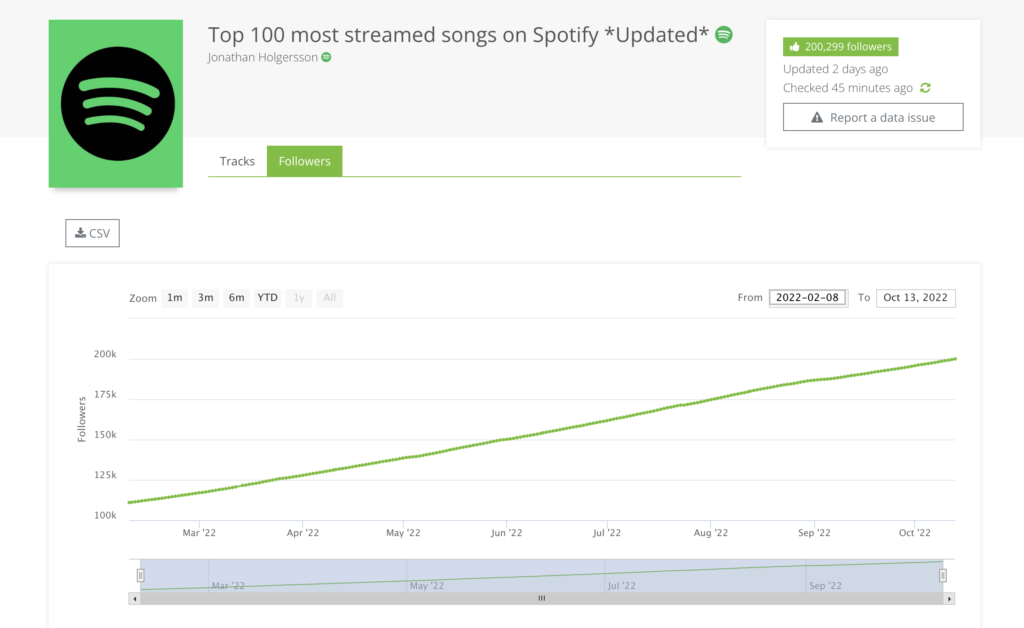
That’s an incredibly appealing growth curve. Bot-built playlists tend to show follower spikes and drops, because they’ll add a bunch of followers all at once. Real playlists almost always have a growth curve like the one above, because listeners are added steadily over time.
All of the playlists we were added to have growth curves that look pretty similar.
It’s also worth pointing out that, if you search “most streamed songs” in Spotify, this playlist is the very first result:
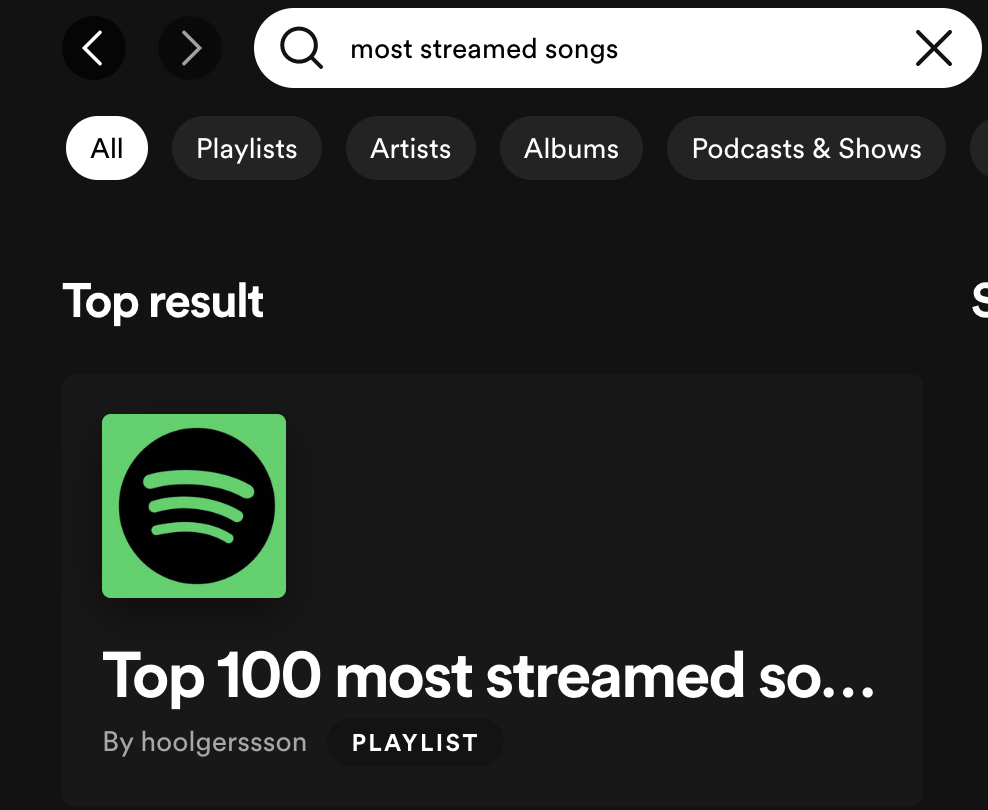
Again, that’s a good sign; it shows one source of traffic to the list (people searching on the platform and finding this result) and it also shows that Spotify likes this list (if it were bot-based, Spotify’s algorithm would probably hate it).
Given the sheer size of this particular playlist, my guess is that it’s also been built with ads. It’s tough to tell from the outside, though.
Anyway, the point is that the first question can be answered positively: Yes, the streams the campaign generated are from real listeners.
So, next question: Are those real listeners engaged?
No, the streams are not from highly engaged listeners.
Before I go any further, I want to clarify that this isn’t really indicative of anything that Playlist-Promotion.com is doing; in general, it’s just a natural feature of playlist-based streams.
Engaged listeners are the ones who notice the song, stream it multiple times, save it, or follow the artist. Passive listeners are the ones who let it go by without taking any action on it.
The reality is that playlists (even the good ones) tend to result in more passive listens, because people put playlists on while doing other activities – having dinner, working out, driving, etc. – and rarely look at their devices while the music plays. There’s really nothing wrong with that, but it means that engagement rates through playlisting campaigns are typically pretty low.
Here’s what I’m talking about:
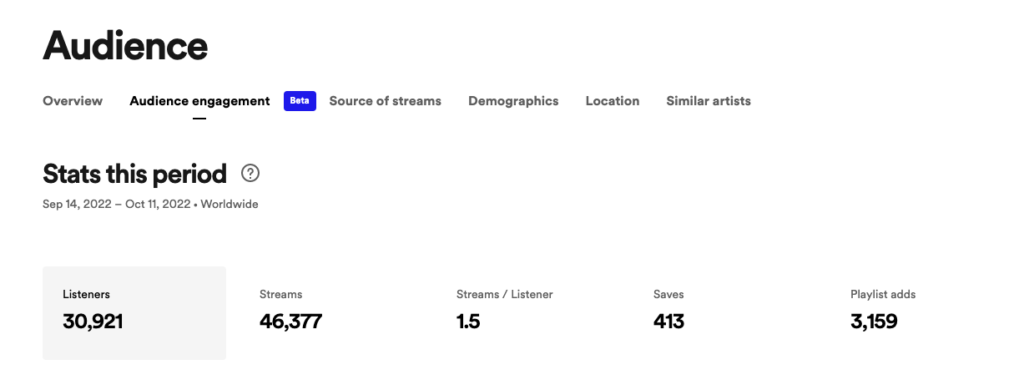
⬆️ That’s Mama Said’s “Audience Engagement” from the past 28 days.
You can see that they’ve got a saves / stream ratio of about 0.9%, which is pretty low. For comparison’s sake, here’s the audience engagement of another artist I work with:

As you can see, the saves / streams rate from this artist is more than double Mama Said’s rate, and they’re a whole stream / listener higher, too.
But before you freak out, there are two big notes here:
- The second artist isn’t actively running playlists, and active playlists always dampen overall engagement rates.
- Over the course of the campaign, Mama Said’s audience engagement has actually been trending in the right direction.
That’s right – Mama Said’s streams / listener ratio is higher now than it was two weeks ago. And the reason for that is perhaps the most encouraging result of the campaign:

That’s Spotify’s Radio algorithmic playlist for “Diamonds & Cigarettes”. It’s driving over 700 streams a month at this point, and it’s climbing, too.
Algorithmic playlists tend to generate high engagement rates, because Spotify is showing the song to people who are pre-selected to really like it. This playlisting campaign has led to more algorithmic streams – and as we get more algorithmic streams, our engagement rates should continue to rise.
Remember, the song was getting next to no streams before the campaign, and it was getting literally zero algorithmic streams. Now, even if it were to be removed from all third-party playlists, I’d expect these algorithmic streams to continue for at least the next several months, because we’ve collected enough data for Spotify to have some idea of where the music fits.
When people talk about “triggering the algorithm”, this is the kind of stuff they mean. Third-party playlists drive spikes, but this is how you generate consistent streaming growth.
Final thoughts on the Playlist-Promotion.com campaign
In case you skimmed everything above / just skipped to the end to get my final verdict, I’m going to offer these as a collection of pros and cons.
The good stuff
Wow, the campaign generated a lot of streams.
If you’re a rising indie artist, 50,000 streams in a month is pretty fun to see. This ranks up there as one of the highest-volume campaigns I’ve seen in that timeframe.
Streams were from real listeners.
Again, all of the playlists we were placed on had solid growth curves, and many of them appeared for keywords in Spotify’s search bar. Plus, all of the data we’ve seen in Spotify for Artists points to real human listeners.
The campaign led to algorithmic streams.
The goal with any playlisting campaign should be to generate good data that leads to algorithmic growth. This campaign has accomplished that goal, and we’re now getting a steady flow of algorithmic streams where before we were getting none.
The bad stuff
Not all of the playlists were great fits.
This is my main critical feedback on the campaign – I don’t think the song is a phenomenal contextual fit for every playlist it was placed on.
Scroll back up there to the three playlists I mentioned, and you can see a couple of things: 1) Some of our top playlists seem to be built for non-English speaking listeners, and 2) our song is categorically not a “Top 100 streamed” song on Spotify, even though it was placed on a playlist claiming to feature the world’s most popular songs.
I’m not too concerned about the international placements, because even though the group is based in California, they’re not opposed to building an international audience. Plus, the top source of streams is still the US:
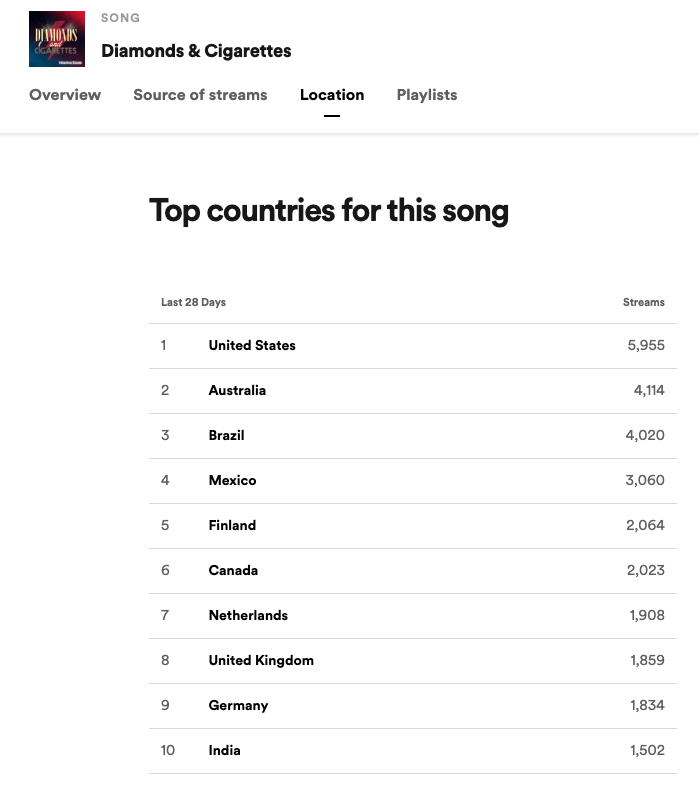
I don’t love the category challenges, though.
Now, I get it. SEO-built playlists (the ones that attract real listeners through Spotify’s search bar) are often built around popular search terms, and popular search terms can be kind of weird.
My brother, for instance, is an indie artist in Nashville, and he owes a big chunk of his streams to a playlist called “Where the Crawdads Sing Soundtrack,” even though his song was definitely not in that movie. Soundtrack playlists, festival playlists, TikTok trend playlists – most playlisting companies use these lists because they’re built with real listeners, but the trade-off is that they’re often misleading contexts in which to place indie artists.
Put more simply: I don’t love the idea of getting a song placed in a “Top 100 streamed songs” playlist when the song isn’t one of the top-100-streamed songs.
Now, in Playlist-Promotion.com’s defense, they did largely focus on genre-related playlists; Andi, our campaign manager, noted that 21 of the playlists we were placed on “corresponded to genre”, while two playlists were “mixed”. That’s awesome. But, despite the volume of genre-specific lists, the “mixed” playlists drove highest percentages of streams, because they had the biggest followings.
Anyway, you get the idea – in general, my favorite placements are the ones that are contextually relevant and drive active listeners. For instance, Playlist-Promotion.com got us into a list called “Female Fronted Rock Bands” – that’s exactly where Mama Said should be.
It’s really tough to parcel out the data, but my guess is that the streams from placements like that one tend to be more engaged than streams from “Soundtracks” or “Top 100” playlists.
The final verdict
This was a really good campaign.
I asked the band how they felt about the results, and here’s what they said:
“This campaign far and away outperformed anything we’ve done to date. (Drop, Submithub, Groover, or Musosoup.) None of our songs crested 1K through other campaigns and we’ve now crested 40K for Diamonds, and all our songs are trending upward. Our follower count is trending upward, monthly listeners is bigger than ever and there are “8 people listening now” and that has never happened. And the music has reached over 100 countries! Whatever the analysis, it’s exciting for us.”
After the analysis, I’d generally agree. While in an ideal world, I’d like to see only contextually-relevant playlist placements, it’s hard to quibble with the results. We’ve gotten ~50,000 streams, and while engagement rates aren’t super high, we are getting some algorithmic growth that promises to make engagement rise over time.
All told, this is an efficient way to drive streams and a legitimate option for Spotify growth.
You can give Playlist-Promotion.com a try here.
Okay, that’s all I’ve got.
If you’ve had an experience with Playlist-Promotion.com, let me know in the comments, and feel free to ask any clarifying questions there, too.
Hope this breakdown was helpful, and I hope that, whatever you try, you find the results you’re looking for.
Here’s wishing you good luck.

